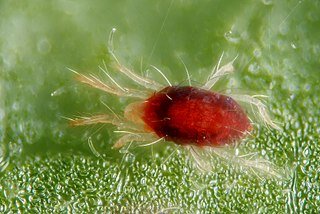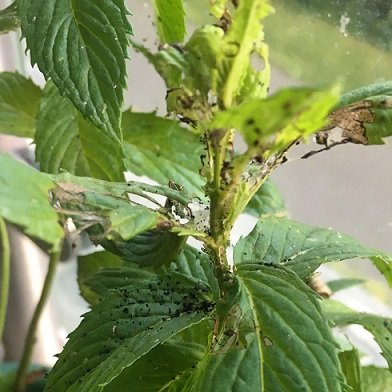Mint is a well-loved plant because of its scent and flavour. However, it is a vulnerable herb without many natural defences.
Along with attracting favourable insects, the mint also attracts a lot of pests that can damage or destroy your Mint.
Spider mites

There are several types of mites, but the mite associated with causing damage to mint plants is the two-spotted spider mite.
These two-spotted spider mites are small and translucent, living on the underside of mint leaves. They are attracted to new plant growth and cluster together in such places.
Symptom – If you see yellow or brown spots on the leaves of your mint plant, you might have a spider mite infestation. Besides this speckled discolouration, they spin thin, frayed webbing throughout the leaves, like a spider.
Spider mites thrive in hot, dry and arid conditions. If your plant has spider mites, there is a good possibility that your plant is underwatered.
Treatment:
You can blast water on your mint plant to get rid of these pests. Because mites live in dry conditions, adding water to the plant can help keep the soil moist and thus keep these pests away.
You can use a plant-based insecticide such as pyrethrum or rosemary oil. These insecticides can kill off the mites without causing any harm to the plant or any other creatures.
Neem oil is also a natural miticide, a chemical agent that is especially effective at killing mite infestations. Other organic treatments include garlic water and hydrogen peroxide.
Potassium salts are quite useful against spider mites.
You can introduce other favourable insects to your plant, such as the ladybug, which prey on these mites.
Applying rubbing alcohol to the affected areas can also help get rid of the spider mites.
Loopers
The Alfalfa Looper and the Cabbage Looper are both pests for the mint plant, but the cabbage looper is more common.
They are 1 to 2 inches in length and are green in colour. Loopers are named for the way they move their bodies.
Loopers can cause significant damage to the mint plant, as they eat large portions of the leaves and stems of the mint plant. They are especially attracted to new growth.
Symptom – If there are holes or bite marks throughout your plant, or any sort of cocoon shedding, there is a high chance of loopers being present.
Thankfully, loopers are easily visible to the naked eye, so just regularly checking your plant for signs of the pest can help in saving your plant before any damage occurs.
Treatment:
If the number of worms all over your mint is relatively small, you can just pick them off by hand. Place them in a bucket of soap water to dispose of them.
Also, make sure you check the underside of leaves for any eggs that might have been laid by the loopers.
You can also use Bacillus thuringiensis, an organic compound that can kill the worm without harming other animals. You will have to trim the mint to the ground before spraying.
Pepper spray can also be effective against loopers as they do not like the heat or the smell of pepper.
Aphids

Aphids are small insects that are green or yellow in colour and live on the underside of the leaves. They bite into the leaves and suck out the juices.
Symptom – Signs of an aphid problem include curled, distorted and yellow leaves that have been damaged and discoloured, spotting, and stunted growth.
You might also see a kind of sooty mould on the plant, which is honeydew, a substance secreted by aphids. They can turn the mint leaves black.
Aphids spread rapidly and can heavily infest the plants if they are not checked and controlled.
Treatment:
The treatment for aphids will depend on the severity of their infestation.
If there are only a few aphids on your plant, you can just prune off the leaves they are on.
You can also spray water on the leaves to knock off the aphids.
Some aphids can be kept away by using reflective mulches. Even some bright and shiny objects can deter aphids.
A mixture of water and dish soap can handle a light infestation of aphids.
If the infestation is severe, you might want to use insecticide. Insecticides with imidacloprid can kill aphids without harming beneficial insects like bees or butterflies.
An insecticidal soapy spray will strip the aphids off their cell membranes. An oily solution will smother them.
Flea beetles
Flea beetles are dark coloured with shiny backs. They are known for jumping high, like fleas.
Symptom – You can easily spot them as they will jump high when you disturb the mint plant.
They cause damage by chewing holes through the leaves of the plant and stripping the leaves of their vibrance.
Flea beetles also carry diseases like blight, so it is very important to be on the lookout for them.
Treatment:
Flea beetles jumping can be used to your advantage. You can incorporate sticky traps near the plant to capture them when they jump.
Flea beetles are soft-bodied, so they are very vulnerable to solutions such as neem oil or soapy water.
You can create a mixture of two cups of rubbing alcohol, five cups of water, and one tablespoon of liquid soap. Spray it on your plant to keep the beetles away.
Dust your plants with talcum powder.
Applying diatomaceous earth near your plants will kill the beetles when they crawl over them.
Seedlings are most affected by these beetles. Hence, it is advisable to keep them covered until they have been established.
Cutworms
Cutworms are the larvae form of moths. They are named so because they literally cut through the plant as they feed on it. They mostly feed on the stems of the plant.
Symptom – A sure sign that you have a cutworm infestation is if your seedlings have been cut off at the base, cuts and holes throughout the plant, and actually spot these insects in the soil during evening times.
If the damage is not visible at the stem, you might see your plant shrivel and die.
Treatment:
If the cutworm infestation is small, you can get rid of them manually by picking them off the plant.
Cutworms are dormant during the day and become active at night. This is the best time to get rid of them. Use gloves to pick them as you see them and drop them in a bucket of soapy water to kill them.
Another remedy is to use diatomaceous earth. It dehydrates any insect that walks through the powder. Create a barrier around the base of your mint plant.
An insecticide like Bacillus thuringiensis can also help kill off cutworms. Apply it in the afternoon so that it will work when the cutworms come out at night.
Thrips

Thrips are small pesky insects that feed on various plants. They puncture the plants and suck their juices. These flying insects also carry potential diseases.
Symptom – Signs of thrip infestation include leaf spotting, streaking, curling and shrivelling.
Treatment:
Adult thrips can be removed using sticky traps.
Spraying water can help prevent infestations from breaking out and damaging your plants.
Favourable insects like ladybugs and pirate bugs can help as they prey on thrips.
The natural bug spray pyrethrin affects a thrip’s nervous system, paralyzing them and killing them as they come in direct contact with it.
Apply to infected areas to kill the thrips and prevent breeding.
Mealybugs
Mealybugs are some of the most common pests that infest the mint plant.
Symptoms – They are white and fluffy in appearance, making it easy to spot them.
Mealybugs feed on the leaves and stems of the plant and suck out their juices. This results in a mint plant with stunted growth and discoloured leaves that droop and fall early.
Treatment:
You can get rid of mealybugs by applying soapy water or rubbing alcohol on the affected areas with a cotton bud. Let it sit for a few hours and then wash it off.
Neem oil is also an effective remedy for mealybugs. It suffocates the adult bugs and can also be helpful in preventing larvae from maturing.
Other pests that infest the mint plant are the Hairy caterpillar and the Root-lesion Nematode.
Why does my mint plant have pests?
All pests thrive in certain specific conditions.
If your mint is being infested by the same type of pest, again and again, you might need to look at the underlying cause and make changes accordingly so that it does not bother your mint again.
That being said, there are a few factors that can help aid pests in destroying your plant.
Humidity
Humidity can be a major cause for pests thriving on your mint. A lot of pests do well in very humid conditions.
Certain types of caterpillars like the hairy caterpillar or the looper are provided natural breeding grounds in a humid environment. These pests cause the most harm during their larvae phase.
On the other hand, very low humidity can also cause problems. A lot of the pests like spider mites, mealy bugs, aphids and more thrive in dry, arid conditions.
In that case, increasing the humidity by watering more often or by misting your mint plant can help prevent this problem.
Wetness
A lot of insecticides use dehydration to instantly kill pests. The reason is that these pests need moisture to live. If your plant or soil is too wet or soggy, it is going to attract pests.
A lot of fungi and viral diseases also breed and spread faster in damp conditions.
If your plant looks moist but is drooping, you might be overwatering it.
Poor ventilation
Plants need a good flow of air in order to stay healthy. Proper ventilation ensures that your plant and soil dry on time and do not stay damp.
Poor ventilation will make the plant and surroundings soggy, which is perfect for pests to breed on.


